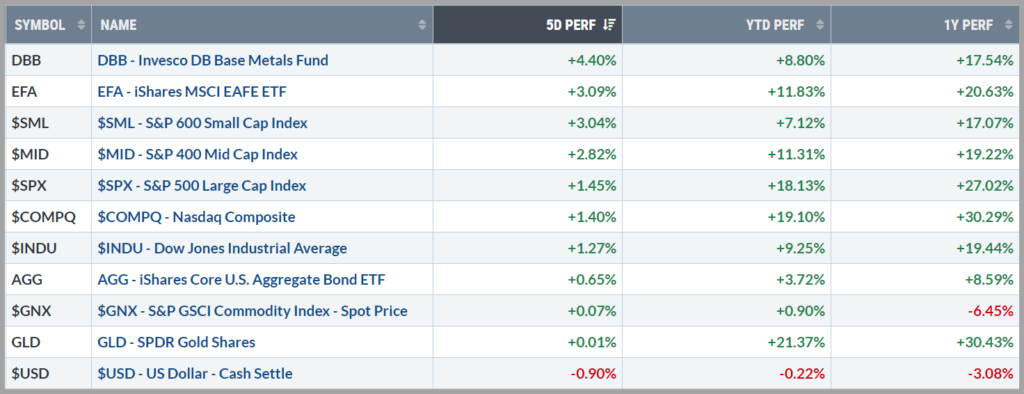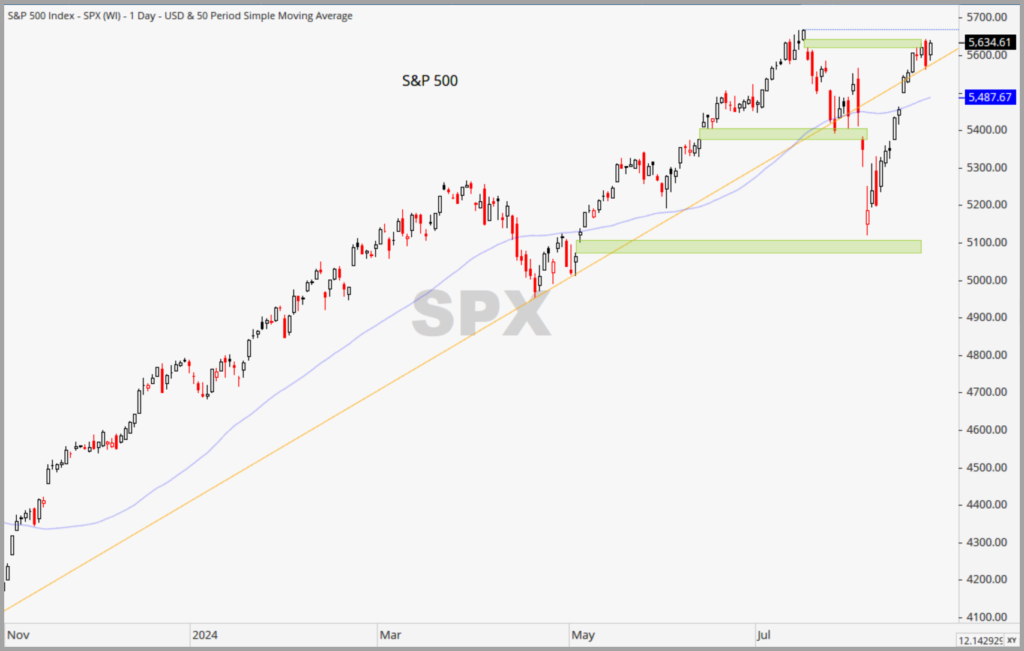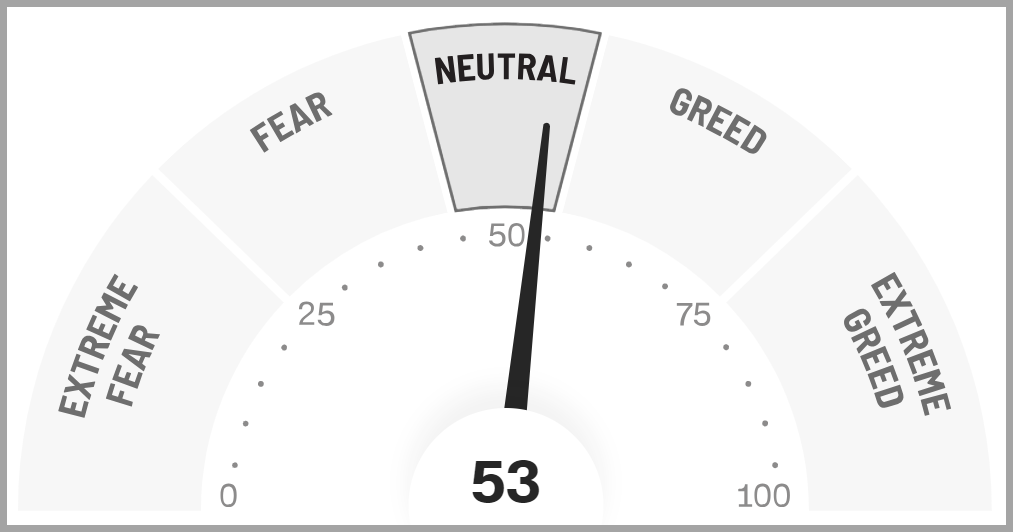Weekly Market Insights
Stocks rallied last week amid heightened volatility as investors processed mixed economic and earnings data along with comments from Fed Chair Jerome Powell suggesting that “the time has come” to begin cutting interest rates. The S&P 500 gained 1.45% for the week while small and mid-caps posted returns of around 3%.
Early in the week, U.S. equities rose modestly on limited financial news, with underwhelming reports on E-Commerce Sales and the Leading Indicators Index bolstering the case for a September rate cut. Despite this positive start, the S&P 500’s eight-day winning streak ended Tuesday as Yen Carry Trade concerns reignited. Later in the week, a significant downward revision to Bureau of Labor Statistics jobs data (the largest revision in 15 years), further supported expectations for a 50-basis point rate cut next month and the markets began to rally. The buying continued into the end of the week aided by numerous favorable comments from our Fed chair at the Jackson Hole Symposium.
Treasuries yields and the dollar fell to new lows for the year and industrial metals soared due to Powell clearly putting forth the idea that interest rates will be cut. Gold held on to recent gains while Oil traded down to its lowest levels in months on easing geopolitical tensions.

Source: www.stockcharts.com

Key Takeaway:
In Friday’s Jackson Hole speech, Fed Chair Jerome Powell signaled that the Federal Reserve is likely to cut interest rates at its upcoming meeting in September. While he didn’t explicitly say so, Powell did mention that inflation is now “much closer to our objective,” with prices having risen 2.5% over the past year, and expressed growing confidence that inflation is on a sustainable path back to 2%.
This shift in confidence suggests that the Fed is ready to adjust policy, which was previously contingent on a clear path for inflation. Powell did, however, caution that the timing and pace of rate cuts will depend on incoming data, evolving economic conditions, and the balance of risks.
The urgency for a rate cut has intensified, seemingly due to the weakening labor market. Last month’s disappointing jobs report and the Bureau of Labor Statistics’ recent revision, which slashed job gains by 818,000—the largest cut in 15 years—highlight the growing risks to employment while inflation concerns have eased.
Markets are approaching recent highs and a technical Gap near the top was filled last week. Valuations are once again “frothy”, and the recent highs now act as a potential resistance level. September is historically a volatile month and the technical set up, coupled with valuations and recent growth concerns, appear to support this type of environment in 2024.
The Week Ahead:
According to statistics derived from the options market, this week’s “Expected Move” (EM) for the S&P 500 is +/- 116 points, 11 points less than last week’s EM, but still large at nearly 2%. This week’s key focus is Friday’s Core PCE price index, which most are expecting to show a decline in this inflation metric. If it comes in below 2.6% year-over-year, it could boost expectations for a 50-basis point rate cut, likely benefiting stocks. Conversely, a higher-than-expected figure might dampen hopes for a larger cut and create a mild headwind for stocks and bonds. On the growth side, Monday’s Durable Goods data will be closely watched for signs of stability in business spending, as any decline could be a negative signal for the economy.

Source: Trading Economics (https://tradingeconomics.com/united-states/calendar#)
Tidbits & Technicals: (New developments will be denoted via***)
Current Headwinds:
- Valuations seem frothy given the current rate environment, leaving the markets subject to a potential swift pullback!
- “Higher for Longer” – Risk that the Federal Reserve waits too long to begin lowering rates and threatens economic growth.
- Very narrow market participation, apparently driven primarily by mega cap tech and AI-related companies, has dominated the indices; however, over the last several weeks we have witnessed a significant broadening effect with “the rest of the market” participating in returns.
Current Tailwinds:
- Optimism surrounding Artificial Intelligence (AI)
- The Federal Reserve potentially cutting rates in the future.
- Strong Labor Market
- Solid Economic Growth
- Continued Earnings Growth (the pace of which may be slowing)
- Momentum
- ***10-year Treasury yields continue to trade lower and are presently at the lowest levels of this year.
Sentiment:
- Credit Spreads had widened significantly in recent weeks as bond investors are requiring higher risk premium for holding the debt of less creditworthy companies.
- ***The VIX (CBOE Volatility Index) which recently leapt higher, suggesting fear among investors, has calmed down somewhat
- ***The CNN FEAR & Greed Index has moved back to Neutral

Source: https://www.cnn.com/markets/fear-and-greed
Intermarket Trends:
- The major Indices (Dow Jones Industrial Average, S&P 500, and NASDAQ) recently posted new highs signifying a positive long-term trend, however, in the short-term they are trending downward.
- Interest rates have been volatile lately and appear to be trending lower.
- The US Dollar has broken its upward trend line over the past several weeks and is beginning to trend downward
- Gold recently broke out of its trading range to record highs
- ***Industrial Metals, which have been trending lower lately, have reversed course and have been gaining traction
- Oil futures are in the middle of their one-year trading band and appear to be stuck in a trading range
Tying it all together:
Despite the recent rally, we maintain a cautious outlook on the market as some of the recent factors which caused the pullback don’t just disappear overnight. The Bank of Japan’s divergent monetary policy and the ongoing slowdown in the U.S. economy pose some significant risks to markets going forward. Also of note, at the present time, it appears investors may be potentially factoring in a more aggressive interest rate easing cycle than the Fed might deliver, while several historically relevant “warning signals” have been fired off recently. These realities, coupled with late-stage business cycle dynamics, have historically created a more challenging environment for stocks in the intermediate-term.
In the long term, economic growth is the primary driver and, while growth remains robust, we are now seeing signs of moderation. This does not mean everything is falling apart; in fact, this was the Federal Reserve Board’s intention. They have held interest rates high for a long time to combat inflation and the expected result of such policies is economic moderation and a cooling of the labor market. The Fed is shooting for a soft landing, a scenario whereby inflation returns towards their 2% target without destroying economic growth, and so far, that scenario appears most likely.
I’m keeping this paragraph below from my prior reports, as it really sums up expectations and what is currently taking place:
“Four main factors have seemingly been supporting the markets — strong growth, falling inflation, expectations of Fed rate cuts, and AI enthusiasm. These drivers remain intact; however, some key economic data points, like rising unemployment, are flashing warning signals at the present time. While the economy is not weak, some of the data suggests a weakening trend and this is a concern given the equity markets are not acknowledging the possibility of any sort of economic contraction. Current valuations have certain equities priced for perfection, so it would be fair to say that any type of growth scare could result in rather extreme volatility in the short run.”
I want to reiterate that the best approach in these environments is to ensure that one’s overall portfolio aligns with their risk tolerance and long-term goals and, add to this, the importance of keeping emotions at bay. Markets tend to overreact to both positive and negative data and keeping a calm perspective has always proven prudent.
Tactically, we recommend maintaining long-term investment exposure to equities focusing on lower volatility sectors and value factors at the present time. We also encourage a fair amount of duration and high quality, investment grade bonds in an effort to mitigate portfolio risk.
Please feel free to share these commentaries with friends and family and, should you have any questions regarding your current strategy or the markets in general, please reach out to your CIAS Investment Adviser Representative.
Important Disclosures:
Past performance is not indicative of future results. This material is not financial advice or an offer to sell any product. The statements contained herein are solely based upon the opinions of Edward J. Sabo and the data available at the time of publication of this report, and there is no assurance that any predicted or implied results will actually occur. Information was obtained from third-party sources, which are believed to be reliable, but are not guaranteed as to their accuracy or completeness.
The actual characteristics with respect to any particular client account will vary based on a number of factors including but not limited to: (i) the size of the account; (ii) investment restrictions applicable to the account, if any; and (iii) market exigencies at the time of investment. Capital Investment Advisory Services, LLC (CIAS) reserves the right to modify its current investment strategies and techniques based on changing market dynamics or client needs. The information provided in this report should not be considered a recommendation to purchase or sell any particular security. There is no assurance that any securities discussed herein will remain in an account’s portfolio at the time you receive this report or that securities sold have not been repurchased. The securities discussed may not represent an account’s entire portfolio and in the aggregate may represent only a small percentage of an account’s portfolio holdings. It should not be assumed that any of the securities transactions, holdings or sectors discussed were or will prove to be profitable, or that the investment recommendations or decisions we make in the future will be profitable or will equal the investment performance of the securities discussed herein.
CIAS is a registered investment advisor. More information about the advisor, including its investment strategies and objectives, can be obtained by visiting www.capital-invest.com. A copy of CIAS’s disclosure statement (Part 2 of Form ADV) is available, without charge, upon request. Our Form ADV contains information regarding our Firm’s business practices and the backgrounds of our key personnel. Please contact us at (919) 831-2370 if you would like to receive this information.
Capital Investment Advisory Services, LLC
100 E. Six Forks Road, Ste. 200; Raleigh, North Carolina 27609
Securities offered through Capital Investment Group, Inc. & Capital Investment Brokerage, Inc.
100 East Six Forks Road; Raleigh, North Carolina 27609
Members FINRA and SIPC


